skip to main |
skip to sidebar
What does the term "salad" mean to you? Something with green leaves, tomatoes and cucumber and radishes, perhaps with a dressing? That's what denotes a salad to me - even now, when I know that practically anything can be a "salad".
I have to say it used to puzzle me. What is pasta salad, anyway? Or - a very strange thing to a South Indian - rice salad? Could South Indian lemon rice or tamarind rice be classified as rice salad?
I'm still not entirely sure why something that is not a salad when hot becomes a salad when cold. Examples? Well, pasta. Eat it cold, and it's a pasta salad. Eat it hot, and it's... well, pasta. Rice, too, undergoes that transition - especially if there's wild rice in there. Take couscous, too. Pizza Hut has cold couscous in its salad bar. When is couscous a side dish, and when is it a salad? More to the point, why is it a salad when it's cold? And then those hot salads - how do THOSE come about without becoming not-salad?
I don't mean any disrespect to the West when I say that perhaps everything is a "salad" here because they don't know how else to classify the various cooked foods from other cultures? What do you think?
This recipe could be a salad, or not. It could be a side dish. Or merely a form of couscous upma. Here's a thought - perhaps we Southies call everything "upma" because salads aren't really in our culinary heritage?
Because I don't know what to call my recipe - salad, side dish, upma, whatever - I'm terming it "couscous with lentils". At least it has the virtue of literalness.
Recipe for: Couscous with lentils
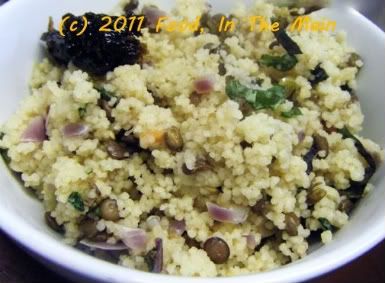 Ingredients:
1/4 cup green lentils
1 bay leaf
1 cup couscous
1 red onion, chopped finely
2 green chillies, chopped
Ingredients:
1/4 cup green lentils
1 bay leaf
1 cup couscous
1 red onion, chopped finely
2 green chillies, chopped
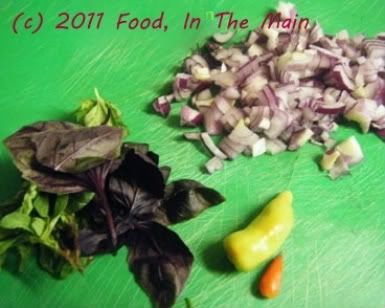 1 small tomato, chopped
2 cloves garlic, minced
a handful of fresh basil leaves
Salt and pepper to taste
about 1-1/2 cups vegetable stock (or water)
1 tsp oil
Method:
1. Cook the lentils in salted water along with the bay leaf, till they're cooked but not mushy.
1 small tomato, chopped
2 cloves garlic, minced
a handful of fresh basil leaves
Salt and pepper to taste
about 1-1/2 cups vegetable stock (or water)
1 tsp oil
Method:
1. Cook the lentils in salted water along with the bay leaf, till they're cooked but not mushy.
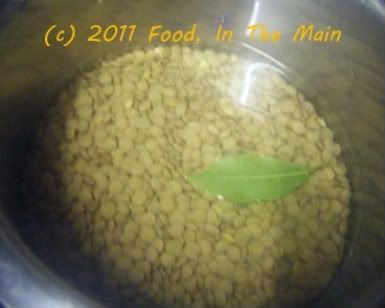 Drain and reserve.
Drain and reserve.
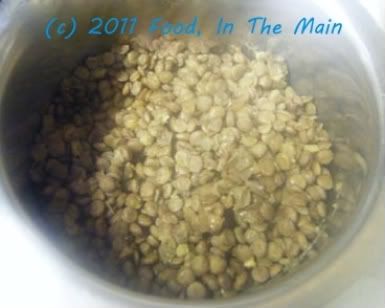 2. In a medium size pan, heat the oil and add the chopped chillies, garlic and red onion. Stir well.
2. In a medium size pan, heat the oil and add the chopped chillies, garlic and red onion. Stir well.
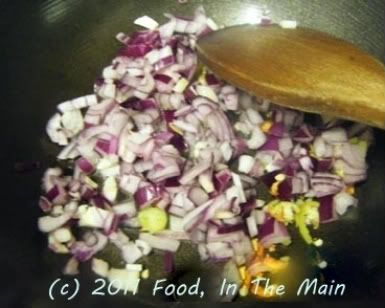 3. Let the onions soften a little, then add the chopped tomato.
3. Let the onions soften a little, then add the chopped tomato.
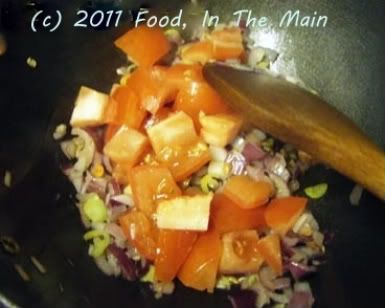 4. Once the tomatoes are beginning to break down, pour in the stock and bring to a brisk boil.
4. Once the tomatoes are beginning to break down, pour in the stock and bring to a brisk boil.
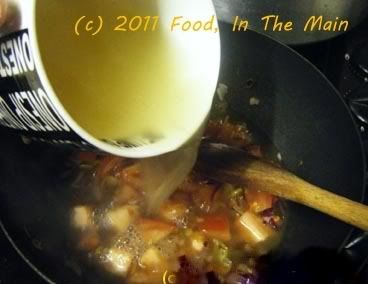 5. Now add the couscous and stir it well. Add salt to taste and bring back to the boil.
5. Now add the couscous and stir it well. Add salt to taste and bring back to the boil.
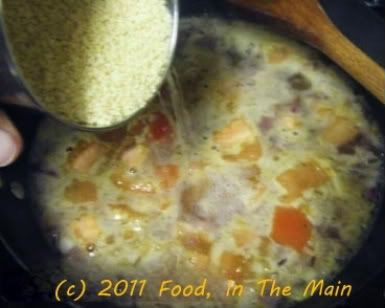 6. Turn off the heat and cover the pan with a well-fitting lid. Let the couscous rest for 10-15 minutes.
7. Once all the water has been absorbed, fluff up the couscous with a fork. Add the reserved lentils and freshly ground pepper to taste, and toss to mix, or fork it through to mix.
6. Turn off the heat and cover the pan with a well-fitting lid. Let the couscous rest for 10-15 minutes.
7. Once all the water has been absorbed, fluff up the couscous with a fork. Add the reserved lentils and freshly ground pepper to taste, and toss to mix, or fork it through to mix.
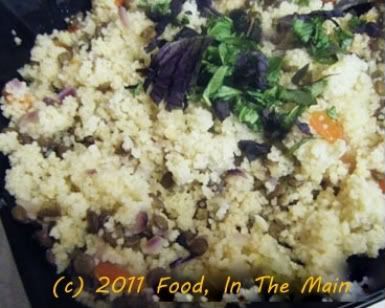 8. Garnish generously with shredded basil leaves and serve the couscous warm as a side with lamb dishes, or as a snack.
RECIPE: COUSCOUS WITH LENTILS
Ingredients:
1/4 cup green lentils
1 bay leaf
1 cup couscous
1 red onion, chopped finely
2 green chillies, chopped
1 small tomato, chopped
2 cloves garlic, minced
a handful of fresh basil leaves
Salt and pepper to taste
about 1-1/2 cups vegetable stock (or water)
1 tsp oil
Method:
1. Cook the lentils in salted water along with the bay leaf, till they're cooked but not mushy. Drain and reserve.
2. In a medium size pan, heat the oil and add the chopped chillies, garlic and red onion. Stir well.
3. Let the onions soften a little, then add the chopped tomato.
4. Once the tomatoes are beginning to break down, pour in the stock and bring to a brisk boil.
5. Now add the couscous and stir it well. Add salt to taste and bring back to the boil.
6. Turn off the heat and cover the pan with a well-fitting lid. Let the couscous rest for 10-15 minutes.
7. Once all the water has been absorbed, fluff up the couscous with a large fork. Add the reserved lentils and freshly ground pepper to taste, and toss to mix, or fork it through to mix.
8. Garnish generously with shredded basil leaves and serve the couscous warm as a side dish with meat dishes, or as a snack.
8. Garnish generously with shredded basil leaves and serve the couscous warm as a side with lamb dishes, or as a snack.
RECIPE: COUSCOUS WITH LENTILS
Ingredients:
1/4 cup green lentils
1 bay leaf
1 cup couscous
1 red onion, chopped finely
2 green chillies, chopped
1 small tomato, chopped
2 cloves garlic, minced
a handful of fresh basil leaves
Salt and pepper to taste
about 1-1/2 cups vegetable stock (or water)
1 tsp oil
Method:
1. Cook the lentils in salted water along with the bay leaf, till they're cooked but not mushy. Drain and reserve.
2. In a medium size pan, heat the oil and add the chopped chillies, garlic and red onion. Stir well.
3. Let the onions soften a little, then add the chopped tomato.
4. Once the tomatoes are beginning to break down, pour in the stock and bring to a brisk boil.
5. Now add the couscous and stir it well. Add salt to taste and bring back to the boil.
6. Turn off the heat and cover the pan with a well-fitting lid. Let the couscous rest for 10-15 minutes.
7. Once all the water has been absorbed, fluff up the couscous with a large fork. Add the reserved lentils and freshly ground pepper to taste, and toss to mix, or fork it through to mix.
8. Garnish generously with shredded basil leaves and serve the couscous warm as a side dish with meat dishes, or as a snack.
I've never been to the Deep South, but just mention the word "jambalaya" to me, and my imagination immediately finds itself in deepest darkest Louisiana - or as deep and dark as Gonzales is, that is. I dont know what it's like, you see, because while my imagination has set foot in the Jambalaya Capital of the World, my foot has not.
Actually, if ever I DO manage to be there (in person, that is) for the Jambalaya Festival, it would be the most pointless exercise in terms of my ability - or rather, inability - to eat this renowned Creole/Cajun dish... the reason being that I'm 99.99% vegetarian and prefer my food not to have been sentient at any point in its lifetime. I guess I could always savour the experience, if not the food...
Anyway, I decided to make jambalaya at home, as the first dish made on the first day of the new year. I had some vegetarian sausages (made of soya) that Pete had kindly bought for me on an impromptu shopping trip. While on the subject of vegetarian sausages and other meat-replacement attempts, do you know just how difficult it is for non-vegetarians to understand that genuine Indian veggies like me do NOT crave for meat substitutes, whether in texture OR taste? The mock-meats and soya/tofu products are all for former carnivores who miss their carne. It's by turns tiring or boring - sometimes both - trying to explain, and even in these enlightened days, I get the occasional baffled "But what do you eat?" question.
Digression aside, the jambalaya recipe that served as the basis of my inspiration was Jag's, posted on his blog, Route 79. Jag's recipes are painstakingly photographed and captioned and believe me, I go there sometimes just to read his recipes and drool a little. (Ok, drool a lot. Dammit, this honesty thing is overrated.) As far as I'm concerned, everything vegetarian he has on his blog is on the list of "my favourite foods", all of them crowding for first position.
I say that Jag's recipe is the basis of mine because I had to make some substitutions and omissions for the usual reasons. For instance, I didnt have celery (mainly because I dont like it!), so I used a little 21-seasoning mix that's strong on celery seed, as a substitute. I didnt use chicken or prawns or chorizo sausage either. What I followed were the actual cooking instructions from Jag's recipe. A good thing too, because the rice was cooked to perfection. Not dry, not mushy, not clumpy - just perfect.
Recipe for: Jambalaya
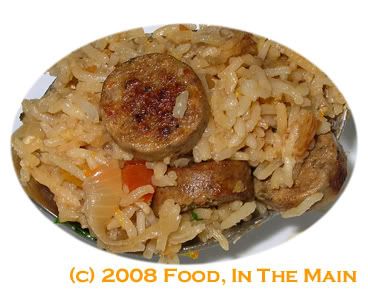
Ingredients:
1 cup vegetarian sausages cut into 1-cm rounds
2 medium onions, sliced into long thin pieces
1 large green (or any other colour) bell pepper, sliced long and thin
1/2 tsp celery seed (or use 1 celery stick, sliced thin)
1" piece ginger, grated
3 cloves of garlic, chopped or grated
1 chicken or vegetable stock cube
2 medium tomatoes, finely chopped
2 tbsp periperi, tabasco, habanero or any other spicy sauce (or as per taste)
2 cups basmati rice, washed and drained
4 cups boiling water
2 tbsp oil
2 bay leaves
1 tbsp chopped flat-leaf parsley
2 tbsp chopped spring onions for garnish
Method:
1. Prepare the stock using the stock cube and the 4 cups of boiling water. Stir in whichever spicy sauce you're using. Reserve.
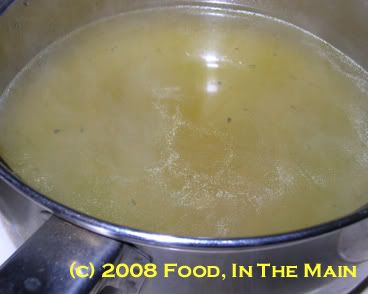
2. Pour 1 tsp oil in a large pan (make sure it's one with a lid that fits correctly) and fry the "sausage" pieces, stirring often, till golden.
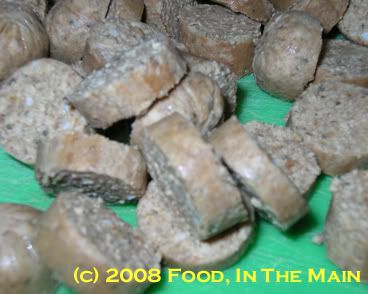
Remove from the pan and reserve.
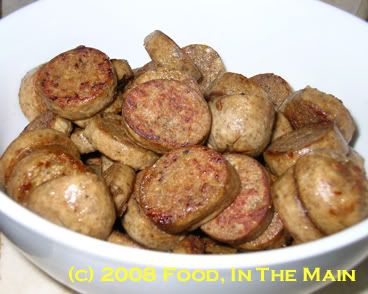
3. Now pour the remaining oil into the pan and add the onions.
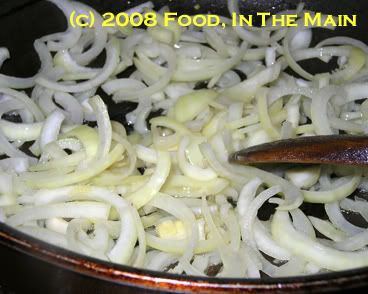
4. When they start softening slightly, add the sliced bell peppers.
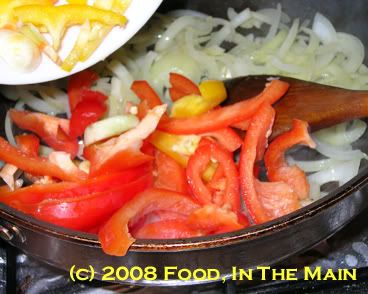
5. Turn the heat up to high and stir fry till the onions and peppers begin to acquire brown edges.
6. Now add the chopped garlic and ginger and stir fry for a minute or so.
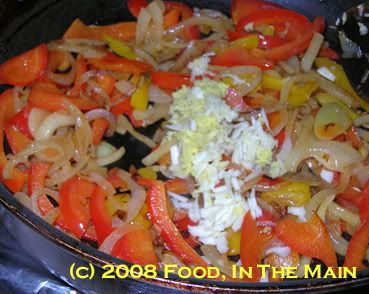
If you're using celery, add it now and stir it all around for a couple of minutes more.
7. Toss in the fried "sausage" pieces and stir it in, making sure the pieces are coated with whatever oil is left in the pan.
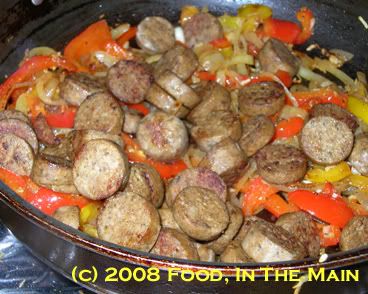
8. Then add the drained soaked rice, stirring it in till well distributed.

Pour in the prepared stock and stir, letting the liquid come to a bubbling boil.
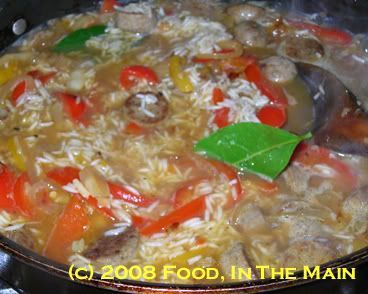
9. When the stock is bubbling, add the bay leaves and the chopped tomatoes. Stir them in.
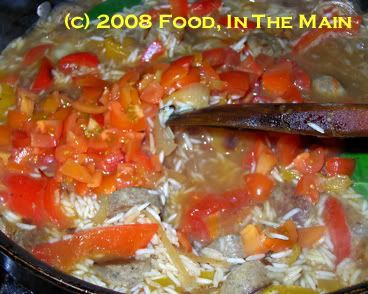
10. Cover the pot and turn the heat down as low as possible. Leave the rice to cook covered and undisturbed for 20 minutes. Do NOT lift the lid or you will lose precious steam and the rice will not cook well.
11. After 20 minutes, turn off the gas and let the jambalaya sit covered for 10 minutes in the pan. Then take off the lid (ahhhh the aroma!),
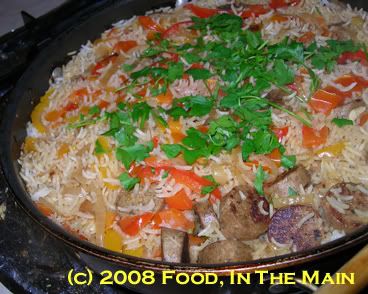
sprinkle the chopped parsley and spring onions over, and serve the jambalaya hot.
Just saw the entry over at Nupur's One Hot stove for ARF/5-a-day Tuesday#2 hosted by Sweetnicks and decided to make my entry as well. I dont usually have the opportunity (or the imagination) to take part in the various competitions that come along, but this one seemed rather easy. PLUS, I was going to make carrot and coriander soup anyway! :)
Why carrot and coriander soup? Because I had 250gm of Chantenay carrots that needed using up, ditto a bunch of wilting coriander. Yep, that's the other reason - because the ingredients were going waste. I guess it's as good a reason as any to cook up something.
I've not made carrot & coriander soup before, although I've had it once or twice. I'm not crazy about carrots unless they are raw - either eaten as is, or in a salad - and I absolutely dont like them boiled or roasted. So the first time I had carrot-coriander soup, it was quite a revelation... not too "boiled carroty", beautifully savoury, with a touch of sweetness that probably came from the carrots. Maybe it was just the recipe used by that particular chef, I dunno. Still, I decided to give it a go and make it myself - and the end result, although it didnt taste like that unknown chef's, was pretty good. The soup, with a loaf of store-bought crusty French boule, made a very nice light supper.
Recipe for: Carrot and coriander soup

Ingredients:
4 medium carrots, peeled and chopped into chunks
1 bay leaf
1 medium onion, chopped
2 tbsp chopped shallots (optional)
2 cloves garlic, chopped
1 bunch coriander, cleaned and chopped (about a cupful). Reserve a tbsp of the stems.
1 tsp black peppercorns
1 tbsp butter + 1 tsp oil
Salt to taste
4 cups water, or as required
1/4 cup milk
1/2 tsp cinnamon powder, for garnish
A few coriander leaves, for garnish
Method:
1. Heat the butter in a saucepan and add the bay leaf and peppercorns for 30 seconds.
2. Add the onions and garlic and fry till the onions turn translucent. Then add the carrots, coriander stems and water.
3. Cook the carrots until soft, then remove, cool and puree in a blender along with the coriander leaves.
4. You should have about 2 cups of stock now. Strain the stock to remove the peppercorns and bay leaf.
5. Add the stock and the milk to the puree, until the soup is the consistency you want. Bring to a boil again.
6. Season with salt and freshly ground pepper. Sprinkle the cinnamon powder decoratively over the top of the soup and garnish with coriander leaves.
7. Serve hot with fresh crusty bread.
Funnily enough, there isnt much I can say about this recipe (do I hear a collective sigh of relief?) :) It's simple, filling, aromatic, low-fat and has plenty of vegetables - not much else to ask of a dinner dish, is there? This pulao is one step down from a khichdi, the missing ingredient being tuvar dal. I didnt add it because I wasnt sure if the tuvar dal would cook completely in the microwave.
I'm a bit wary of cooking dals in the microwave because the one time I tried it with tuvar dal, it made an unholy mess when it bubbled over in the oven - and it STILL was only half-cooked. While lots of things are nice al dente instead of mushy, tuvar dal is not on that list.
We had this nearly-khichdi vegetable pulao with a simple tomato raita, but it would be just as nice with coconut chutney or some spicy pickle alongside.
Recipe for: Microwave vegetable pulao

Ingredients:
1 cup basmati rice, soaked in warm water for 30 minutes
2 cups mixed chopped vegetables (any combination of green beans, carrots, spinach, cauliflower, peas, etc)
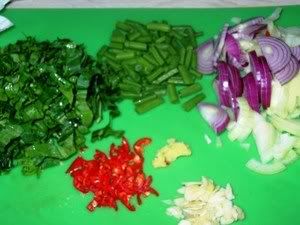
1 onion, sliced thin
1 bay leaf
1 medium-hot red chilli, sliced into very thin rings
3-4 green chillies, slit (optional or adjust to taste)
1/2 tsp garam masala
1 tsp cumin seeds
1 tsp slivered garlic (2-3 pods)
1 tsp ginger root, grated
2 tsp oil
Salt to taste
1 tbsp coriander leaves, to garnish
Handful of roasted/fried cashewnuts, for garnish (optional)
Method:
1. Heat the 2 tsp oil in a pan and add the bay leaf, garlic, grated ginger, slit chillies, sliced red chilli and cumin seeds. Fry for 30 seconds or so, stirring continuously.
2. Add the garam masala and onions and stir-fry till they start turning soft, then add the vegetables and stir again.
3. Drain the rice and add that to the pan as well and fry for 2-3 minutes.
4. Add 2-1/4 cups water and salt to taste. Pour it all into a microwaveable bowl and cook it for 15 minutes or so on high without a cover. (Start with 10 minutes and see if the vegetables and rice are cooked - the cooking time depends on the wattage of the oven.)

5. Cover the bowl and let the pulao rest for 5 minutes. Just before serving, fluff the rice up gently with a fork and sprinkle the chopped coriander over. Also top with the fried cashewnuts, if using.
Serve hot with chilled tomato-yogurt raita.
Quick tomato raita:
1 ripe tomato, chopped fine
1 cup cold yogurt (Greek-style, for preference)
1/4 tsp salt
pinch of garam masala (or molagapodi if you have it)
Mix together and serve as an accompaniment for the pulao.
If you have a pressure cooker, this is a dal that can be made easy as pie. Easier than pie. WAY easier than pie. Pie isnt easy, and whoever thought up that particular expression must have been exercising irony or sarcasm to the nth degree.
Not to get carried away, though, so I'll get back to the theme. Dal made with whole green gram.
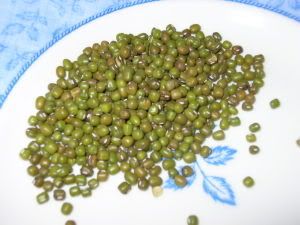
I discovered that these lentils, although bullet hard when dry, dont need soaking if you use a pressure cooker. And although very tasty, this dal is not a fancy dish - it's everyday fare, eaten with plain roti or rice. I know I wouldnt really include it in the main dishes if I gave a dinner party, for instance.
That said, I like dal made with green gram. Funnily enough, though, I dont much like it as "sundal" (a semi-dry cooked snack, seasoned or sweetened), whether sweet or savoury, although the savoury version is marginally better.
Recipe for: Whole Green Gram dal:
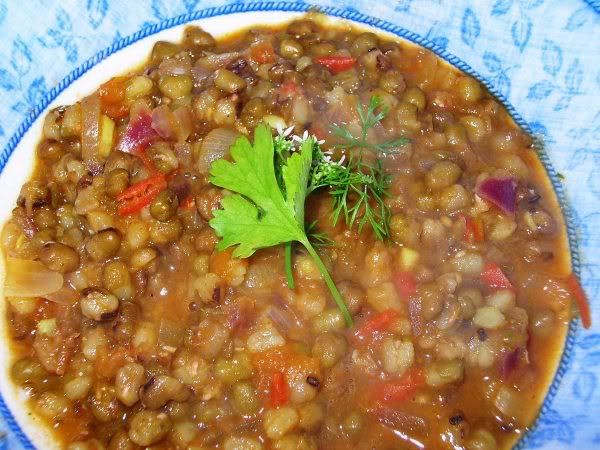
Ingredients:
1 cup whole green gram dal
3-4 medium tomatoes, chopped fine
2-3 cloves garlic, chopped roughly
4-5 green chillies, slit (or to taste)
1 bay leaf
Salt to taste
Two medium onions, sliced thinly
1 tsp ginger-garlic paste
1 heaped tsp whole cumin seeds
1/2 tsp garam or chana masala (optional)
1 tsp red chilli powder (optional)
2 tsp oil
2 tbsp chopped coriander leaves for garnish
Method:
1. Put the dal, tomatoes, garlic, bay leaf and three slit chillies in a vessel along with 1-1/2 cups water. Pressure cook till done. (I usually leave the heat on high and let the cooker get to the point where it emits one shriek - then I turn the heat down and let it simmer for 15 minutes, after which I let the pressure build up again. I turn the heat off after another shriek, and let the cooker be until the lid can be opened.)
2. Meanwhile, heat the oil in a wok or saucepan, sizzle the cumin seeds. Then add the ginger-garlic paste, the remaining slit chillies and the sliced onions.
3. When the onions are half done, add the red chilli powder if using. Cook till the onions are soft and brown, adding a few tbsp of water if necessary.
4. When the cooker can be opened, discard the bay leaf and the chillies. Carefully mix the cooked dal with the onions, add salt to taste and as much water as required (if necessary) to get a thick but pourable consistency.
5. Let the dal come to a boil, simmer it for a couple of minutes, then turn off the heat. Garnish with the chopped coriander and serve hot over rice or with chapatis.
There's too much spinach in the house at the moment... I know this is beginning to sound like whatever I cook is because I have too much of it lying around. This largesse of spinach wasn't Pete's fault, though (for a change - heheh). We spent Saturday night in Colchester and on our way back, Pete had the good idea of coming back via Birmingham so that I could pick up some Indian essentials and some fresh veg like okra, yam and green bananas. I also bought two bunches each of fenugreek leaves and coriander leaves, but I left the spinach alone. However, I wasnt destined to escape it, because the shopkeeper threw in two bunches of saag to make up the 6 bunches of greens that were selling for one pound. Bah. (I've just realised that I said "bunches" more times in the last couple of sentencesthan I've said them ever!)
Still, spinach isnt such a bad thing. I rather like it. And since there was lots of cooked rice left over from the previous night, the choice was clear about what to make for dinner - spinach rice. With cabbage, since there was half a cabbage in the fridge. It was a Savoy cabbage, but you can use any cabbage really. I prefer the green variety to the white, though. I dont know what would happen if you used red cabbage - speaking colour-wise, I mean.
With green cabbage and green spinach, the rice ends up almost emerald coloured. And it tastes very nice indeed, especially if you use a lot of cheese. This time I used grated paneer to mix with the rice, and medium-strong cheddar to sprinkle over the top, but I've also made it with just cheddar cheese throughout. It tastes just as nice in a slightly different way if you use only cheddar - the texture of the rice becomes stickier because cheddar melts and paneer doesnt.
I suppose this could be classified as some kind of fusion cooking, but I'm not sure what's fused. It's basically Indian, with some cheese added.
Oh, one thing to look out for - big green-toothed smiles after you finish eating!
PS. I took photos of this, but for some unknown reason they didnt register on my camera chip :( Will add a photo the next time I make this recipe again. I'm really bummed out over this because I dont know what I did wrong with the camera - so there's every chance that it will happen again. Bah.
Recipe for: Spinach rice with green cabbage and cheese
Ingredients:
1 cup basmati rice, cooked al dente and cooled
To puree -
3 cups spinach leaves
3 tbsp coriander leaves (optional)
1" piece ginger root
1 clove garlic
For the masala -
1 cup green cabbage (Savoy is ok), shredded
2 onions, sliced into thin strips
1 tsp cinnamon powder
2 whole cloves (or 1/4 tsp cloves powdered)
1 bay leaf
1 tsp coriander powder
1 tsp cumin seeds 4 tbsp lemon juice
1/2 cup grated medium-strong cheese - cheddar or similar (I used 1/4 cup grated paneer and 1/4 cup cheddar)
1/2 cup milk
3 tbsp oil/butter
Salt to taste
Method:
1. Puree the spinach, coriander, ginger and garlic to a smooth paste, using as little water as possible. Reserve.
2. In a flat-bottomed pan, heat the oil. Add the bay leaf, cloves, cinnamon and cumin seeds and fry briefly, then put in the onions and let them cook till they begin to turn brown.
3. Add the shredded cabbage and stir-fry for a minute or two, until the cabbage starts wilting. Then add the spinach puree.
4. Fry this mixture on high heat for a couple of minutes, stirring constantly. Then add half a cup of water and salt to taste, mix again and turn the heat down low. Cover and let cook for 3 minutes.
5. Stir in the coriander powder and take the masala off the heat, then pour in the lemon juice. At this point you can remove the bay leaf and the whole cloves, if you like.
6. Gently mix half the cheese with the rice, taking care not to mush the rice.
7. When the onion-cabbage masala has cooled, mix it with the rice until it's evenly distributed throughout.
8. Put the rice in an oven-proof casserole with a lid. Smooth the top, pour the milk over evenly and then sprinkle the rest of the cheese. You can add more cheese if you like.
9. Bake in a pre-heated 190C oven (375 F) for 20 minutes or so, until the cheese is melted and the rice is heated through. Serve hot with plain salted potato crisps on the side, or crushed and sprinkled on top. Add a dollop of Greek yogurt too, if you like.
Note: You can add green peas, shredded carrots or any other quick-cooking (or pre-cooked) vegetables you like to the onion-cabbage masala.




























